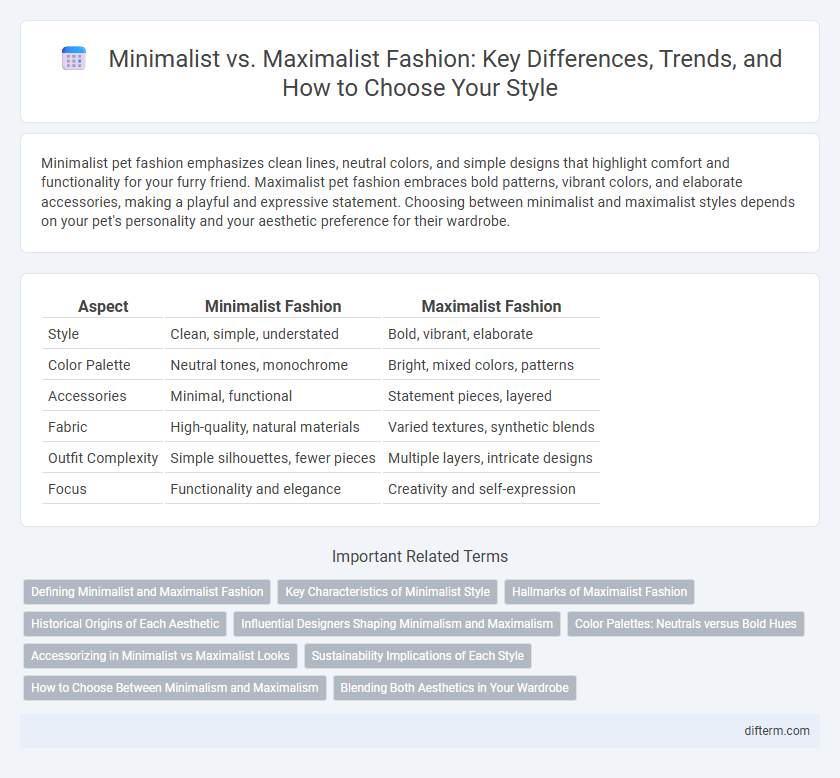Minimalist pet fashion emphasizes clean lines, neutral colors, and simple designs that highlight comfort and functionality for your furry friend. Maximalist pet fashion embraces bold patterns, vibrant colors, and elaborate accessories, making a playful and expressive statement. Choosing between minimalist and maximalist styles depends on your pet's personality and your aesthetic preference for their wardrobe.
Table of Comparison
| Aspect | Minimalist Fashion | Maximalist Fashion |
|---|---|---|
| Style | Clean, simple, understated | Bold, vibrant, elaborate |
| Color Palette | Neutral tones, monochrome | Bright, mixed colors, patterns |
| Accessories | Minimal, functional | Statement pieces, layered |
| Fabric | High-quality, natural materials | Varied textures, synthetic blends |
| Outfit Complexity | Simple silhouettes, fewer pieces | Multiple layers, intricate designs |
| Focus | Functionality and elegance | Creativity and self-expression |
Defining Minimalist and Maximalist Fashion
Minimalist fashion emphasizes simplicity, clean lines, and a neutral color palette, focusing on quality over quantity with timeless pieces and understated elegance. Maximalist fashion embraces bold patterns, vibrant colors, and eclectic layering, highlighting individuality and artistic expression through statement accessories and diverse textures. Both styles reflect distinct aesthetic philosophies that influence consumers' wardrobes and lifestyle choices in contemporary fashion trends.
Key Characteristics of Minimalist Style
Minimalist fashion emphasizes clean lines, neutral color palettes, and functional pieces that prioritize quality over quantity. Key characteristics include simplicity in design, timeless silhouettes, and a focus on versatile wardrobe staples that easily mix and match. Minimalist style avoids excessive embellishments, favoring understated elegance and effortless sophistication.
Hallmarks of Maximalist Fashion
Maximalist fashion is characterized by bold patterns, vibrant colors, and layered textures that create a visually striking and expressive look. Hallmarks include eclectic accessories, mixed prints, and statement pieces that emphasize individuality and creativity. This style rejects minimalism's simplicity, embracing abundance and complexity in design and styling.
Historical Origins of Each Aesthetic
Minimalist fashion traces its origins to the 1920s and 1930s with designers like Coco Chanel, who emphasized simplicity and functionality, reflecting a shift towards modernism and practicality. Maximalist style, influenced by the Baroque and Rococo periods of the 17th and 18th centuries, embraces elaborate patterns, rich textures, and vibrant colors, symbolizing wealth and opulence. These contrasting aesthetics evolved through cultural and social changes, shaping contemporary fashion's diverse expressions.
Influential Designers Shaping Minimalism and Maximalism
Influential designers such as Jil Sander and Phoebe Philo have been pivotal in shaping minimalist fashion through their emphasis on clean lines, neutral palettes, and understated elegance. In contrast, designers like Alessandro Michele at Gucci and Anna Sui champion maximalism with bold patterns, eclectic layering, and vibrant color schemes that celebrate excess and individuality. These visionary creators have defined the aesthetic boundaries, driving the ongoing dialogue between minimalist restraint and maximalist exuberance in contemporary fashion.
Color Palettes: Neutrals versus Bold Hues
Minimalist fashion emphasizes neutral color palettes featuring whites, blacks, grays, and beiges to create clean, versatile looks. Maximalist style embraces bold hues like vibrant reds, electric blues, and rich purples to make powerful visual statements. The choice between these palettes defines the overall mood and personality of the outfit, with minimalism highlighting simplicity and maximalism showcasing exuberance.
Accessorizing in Minimalist vs Maximalist Looks
Accessorizing in minimalist fashion emphasizes clean lines and understated pieces such as delicate gold necklaces or small stud earrings, enhancing simplicity without overwhelming the outfit. Maximalist looks embrace bold, layered accessories like chunky statement necklaces, oversized rings, and vibrant scarves, creating a visually rich and dynamic style. Both approaches use accessories to reinforce their core aesthetic while expressing personal style effectively.
Sustainability Implications of Each Style
Minimalist fashion emphasizes timeless pieces and quality materials, reducing waste and promoting sustainability through slower consumption cycles. Maximalist style often involves frequent purchasing driven by trends, potentially increasing environmental impact due to higher resource use and textile waste. Choosing minimalist wardrobes supports eco-friendly practices by extending garment lifecycle and lowering carbon footprints in the fashion industry.
How to Choose Between Minimalism and Maximalism
Choosing between minimalism and maximalism in fashion depends on personal style preferences and lifestyle needs, as minimalism emphasizes clean lines, neutral colors, and simplicity while maximalism embraces bold patterns, vibrant hues, and eclectic layering. Assess your wardrobe versatility, daily activities, and desired statement to determine which aesthetic aligns with your identity and enhances your confidence. Prioritizing quality over quantity in minimalism contrasts with the maximalist approach that values curated, expressive pieces to create dynamic ensembles.
Blending Both Aesthetics in Your Wardrobe
Blending minimalist and maximalist aesthetics in your wardrobe creates a unique, balanced style by pairing clean, simple pieces with bold, statement accessories or patterns. Incorporate staple minimalist items such as tailored blazers, neutral-toned tops, and streamlined trousers alongside maximalist elements like vibrant prints, layered jewelry, or oversized handbags. This fusion enhances versatility, allowing effortless transitions between casual and statement outfits while expressing individual creativity in fashion choices.
minimalist vs maximalist Infographic

 difterm.com
difterm.com